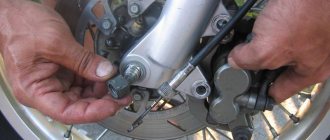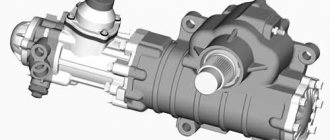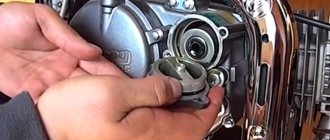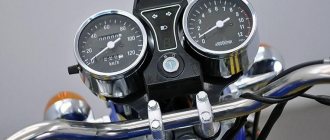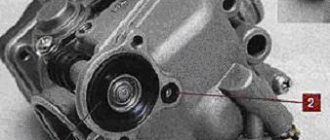Motor oil plays an important role in the engine. The liquid lubricates moving parts, preventing temperature increases at the point of friction. This ensures optimal performance of the power unit, extending its life for many years to come. Oil starvation leads to accelerated wear of engine parts and inevitable breakdown. The four-stroke scooter engine is no exception.
When to change the oil?
The procedure for changing the oil in a four-stroke scooter engine depends on the specific model. Each vehicle has individual characteristics. Some owners can drive up to 5 thousand kilometers and not change the oil, while others have to change it every 2-3 thousand kilometers.
The oil in a new scooter needs to be changed after 300 km. This must be done because break-in lubricant is poured at the factory. It is not recommended to drive on such liquid for a long time. The second replacement should be made after approximately 700 km. Further procedures should be carried out at each technical inspection (approximately once every 3000-4000 km).
The main factors influencing the frequency of oil changes:
- Fuel type and quality;
- Engine capacity;
- Brand of liquid filled;
- Oil condition;
- Replacement method;
- Engine mileage;
- Technical condition of the scooter;
- Method of operation;
- Quality of consumables.
The area in which the scooter is used is suburban or urban.
Characteristics and tuning of the QMJ 157 engine
Various two-stroke and four-stroke engines are used to power Chinese scooters. The most popular are four-stroke motorcycles, which include the QMJ 157 power unit. Engine capacity is 9.2 liters. With. has one 150cc cylinder and is copied from the Japanese GY6 Honda engine model. The drive from the motor to the drive wheel is carried out through a variator included in the delivery package of the engine. Wanting to increase the speed that a motorcycle or scooter develops, they often perform engine tuning.
Engine QMJ 157 - characteristics and general description
Like most equipment produced by Chinese manufacturers, the QMJ 157 four-stroke engine is reproduced from its Japanese counterpart. The power unit installed on a Honda scooter was taken as a prototype. The motor has undergone long-term testing under various operating conditions, proving itself to be reliable, trouble-free and durable.
Various two-stroke and four-stroke engines are used to power Chinese scooters
All that remains for Chinese engineers is to adopt a proven design and begin mass production. How successful the motor turned out can be judged by its area of application. The one hundred and fifty-seventh engine model, the power of which is enough to accelerate a full-size two-seater scooter, is today installed both on expensive scooter models - Honling, Forsage, and on budget scooters like the Viper Storm 150. This power plant has become legendary among fans of Chinese scooters.
The limited speed threshold of the scooter, associated with the relatively small cubic capacity of the engine and the developed power, forces tuning enthusiasts to modernize the engine.
When planning to improve a fairly good motor, you should first familiarize yourself with its technical characteristics. Let's consider the operating parameters of the engine.
Compared to 50cc four-strokes, it has quite good cubic capacity and power. The cylinder has a volume of 149.6 cm3, and the maximum power reaches 6.8 kW. The piston has a diameter of 57.4 mm and a stroke of 57.8 mm. At maximum power, the revolutions reach 7.5 thousand per minute. At 6 thousand revolutions per minute, the maximum torque is 9.8 Nm. Idle speed ranges from 1600 to 1700 per minute. The engine weighs a little - 27 kg.
Before you start using it, you should break in the engine and drive the scooter for 2000 km in compliance with the speed limit. With proper running-in, the engine service life reaches 25,000 km. The motor quickly and dynamically accelerates the scooter with the driver and passenger. A run-in engine does not require intervention and can operate for a long time without major repairs. Then it will be necessary to replace the rings, which does not require a major investment.
This power plant has become legendary among fans of Chinese scooters.
Engine device
Beginning scooter riders, if they need to repair the motor, try to understand its design. Diagram 157QMJ will help you obtain information about the structure of the power unit and its components. Having dealt with it, you can not only purchase the necessary spare parts for the 157 QMJ engine, but also correctly perform the work of assembling and disassembling the engine. Structurally, the motor is practically no different from its GY6 counterpart. The 157 QMJ has the same cylinder-piston group, clutch, crankcase, camshaft and muffler.
The bearing numbers, sizes of silent blocks and gears, diameters of the variator pulleys and the design of the kickstarter, generator and electric starter also correspond. The engine is cooled by the oncoming air flow. Starting is carried out from an electric starter or kickstarter. Torque is transmitted through a variator, which is an automatic integral transmission.
Depending on the design features of the scooter on which the engine is installed, it can be equipped with a CVT having an extended box. The engine is equipped with a standard power system, providing fuel consumption reduced to 2.5-3 liters per hundred. The power unit operates quite quietly, providing almost silent acceleration of the scooter during maneuvers.
The motor is equipped with a standard power supply system
Engine tuning QMJ 157
Why do they tune a fairly reliable engine? Those who like to modernize their scooter explain the need for tuning by the limited speed threshold and the desire to increase power. The fact is that the engines of most scooters, having reached maximum speed, begin to run wild. This not only increases fuel consumption, but also significantly reduces the service life of the engine.
The design of the engine makes it possible to increase its cubic capacity from 150 to 170 cubic meters. To modernize, it is necessary to purchase a number of spare parts, as well as correctly perform the work of disassembling and assembling the motor.
It is important to properly break in the power unit after tuning. Let us dwell in detail on the complex of these issues.
Required spare parts
To carry out engine modernization work, you must purchase the following spare parts:
- four-valve cylinder head with a sports camshaft. The head includes rubber seals, a set of studs, a gasket and a camshaft chain;
- carburetor having an intake manifold with a diameter of 30 mm and equipped with a gasket. Installing a CVK Racing sports carburetor will provide power to the engine after increasing the cubic capacity;
- working cylinder with a sleeve with a diameter of 61 mm and a piston of the appropriate size. You will also need a piston pin, a pair of circlips, compression rings, an oil ring with a retainer and a paper gasket.
After tuning, it is important to properly break in the power unit
. By performing simple calculations, you can make sure that replacing a standard piston with a diameter of 57.4 mm with one increased to 61 mm will increase the volume of the working chamber to 169 cubes. At the same time, the piston stroke length, equal to 57.8 mm, remains unchanged.
Disassembly
Having purchased all the spare parts necessary for tuning, you should study the procedure for disassembling the engine. It is technically possible to complete the entire scope of work without dismantling the power unit itself from the scooter frame.
The work must be performed according to the following algorithm:
- remove the rubber mat and dismantle the seat. You will also need to remove the trunk, the plastic trim around the driver's seat and the exhaust pipe. The muffler remains in the same place. It is important not to confuse the locations of bolts of different lengths;
- dismantle the air purification filter assembled with the power supply system. Instead of the standard filter, which has a reduced throughput, you will need to install a Uni Filter. It will ensure the purification of the required amount of air for a 170 cm3 engine. To remove the carburetor, you will need to disconnect the throttle cable and remove the clamps from the gasoline hoses;
- unscrew the plastic covers that protect the engine from contamination and provide additional circulation of cooling air flows. The plastic casing is removed by unscrewing a group of screws. The plastic is then easily removed. Don't forget to cover the floor with old rags to absorb any oil that drips during disassembly;
Before tuning, study the procedure for disassembling the engine
- Unscrew the 4 M4 bolts securing the cylinder head cover. After this, the cover, under which the rubber gasket is located, will quickly be removed. Don't forget to disconnect the breather hose from the air filter. It will then be mated to the new oil trap;
- unscrew the M12 nuts securing the camshaft and cylinder heads. Remove the upper camshaft mounting elements, ensuring that it does not move. Unscrew the chain tension adjustment cover and loosen the tensioner fastening with a screwdriver. Next, you need to remove the timing chain from the camshaft sprocket;
- unscrew a pair of M8 bolts securing the cylinder head. Carefully remove the cylinder by moving it along the studs. The metal gasket will require replacement as it cannot be reused. Use thin pliers to remove the piston pin retaining ring, after which the piston can be disconnected from the connecting rod.
- install gaskets and rings. It is important not to block the channel in the cylinder intended for lubrication of the cylinder head. When installing compression and oil scraper rings, they should be placed so as to ensure that the gaps are located at an equal angular distance;
- Carefully install the piston inside the cylinder complete with rings. A small amount of lubricant will make the piston installation operation easier;
- Apply sealant to the heat-resistant paper gasket, align with the cavities and channels, and then install the cylinder along the studs. The IN marking on the piston should point towards the intake manifold;
- connect the piston after the connecting rod and pin holes match. Install the cotter pins and make sure the retaining rings are secure. They must coincide with the grooves of the piston. Before starting work, it is necessary to apply lubricant to the piston pin.
Remember that the increased height of the four-valve head will require replacing the four studs that secure the cylinder-piston group to the cylinder head.
How should the studs be installed?
To unscrew the original studs, a standard technique is used, which is used by engine tuning enthusiasts. Screw two nuts onto the threads of the stud and use wrenches to press them tightly together. Then you need to unscrew the bottom nut by rotating it counterclockwise. Before screwing in new studs, apply blue sealant to the threads to prevent turning. The pair of cylinder fixing fasteners on the right side of the engine does not need to be removed.
Assembly
Assembly work is carried out in reverse order. Procedure:
All that remains is to install a new timing chain, making sure that the marks on the engine housing and the generator match. Then you will need to put the cylinder head on the studs, install and fix the camshaft, and also adjust the valve clearance in the range of 0.05-0.1 mm. The final steps are installation of spark plugs, oil catcher, carburetor and air filter. Now you can try to start the engine and start running it in.
157 QMJ engine - characteristics, running and reviews
The performance of a scooter with a tuned engine will increase significantly. It will be able to accelerate to almost 100 km/h. It is important to ensure normal grinding of the rings. To do this, the first start of the engine should not exceed 5 minutes, and the speed should be 50%. After the engine has cooled, you can restart the engine for 10 minutes and slightly increase the speed. After the third 15-minute start, wait until the engine cools down and check for oil leaks. According to owner reviews, the upgraded engine will delight you with improved dynamics and pleasant sound.
What oil should I use?
Available types of oils for four-stroke engines: SAE 5W-20 or 10W-40. Depends on the manufacturer. If the vehicle is often operated in high temperature conditions, it is better to choose a motor oil with a high viscosity index.
What to look for when choosing oil? First of all, on the oil indices, which should be present on the canister label. The chemical composition is also no less important. In addition to the index, the exact amount of additives from the fluid manufacturer is used.
For a four-stroke scooter engine, you can use not only oil that is intended for scooters, but also for equipment: walk-behind tractors, lawn mowers, chainsaws and others.
Why is fresh scooter gear oil necessary?
One of the most important components of a scooter can rightly be called the gearbox. It is responsible for timely reducing the speed of the driven shaft, thereby increasing torque. That is, it converts high shaft and clutch speeds into fairly powerful, but low wheel speeds. This part consists of a number of rubbing elements (gears and bearings) that undergo enormous loads, and, as expected, they need good care. It is the transmission oil that provides such care.
It is an oil doped with various functional additives. The main function of transmission fluids can be called protective, as they protect the surface from wear, corrosion, seizing, etc. In addition, thanks to them, energy losses are reduced and heat removal from friction surfaces is ensured. Shock loads, vibrations and noise in gear drives are also significantly reduced.
The process of changing the oil in the engine 139QMB of a 4t scooter
Necessary tools for changing the oil in the engine 139QMB of a 4t scooter:
- 17 or 19 mm socket wrench;
- Capacity with a volume of 1 liter or more;
- Funnel;
- A little gasoline;
- Rags.
Before starting the procedure, you need to warm up the scooter engine. The oil will become highly fluid and will quickly drain from the system. The next sequence of actions is as follows:
- Place the scooter on a flat surface.
- Using a fine metal brush, clean the filler and drain holes. Filler hole location: on the driver's left side, next to the generator flywheel. There are two drain holes. Location: one at the bottom, the other on the left side.
- Open the filler cap. Without air entering the system, the liquid will not drain.
- Unscrew the drain hole nut. It is recommended to unscrew the bottom plug. This will help rinse the metal filter. Please note: there is a spring on the drain plug. Be careful when unscrewing.
- The oil will drain within 5-10 minutes. While it is draining, wash the nut, filter and spring.
- Screw back the nut, filter and spring. Proceed to fill in new lubricant.
- Use a funnel. Fill the engine crankcase with fresh oil. You can safely pour the first 700 ml of oil, but after that, be careful. Different scooters require different volumes of fluid in the engine (from 800 ml to 1000 ml).
- Check the oil level from time to time. If necessary, top up. Do not let the engine starve of oil.
The process of changing the oil in a four-stroke scooter engine is complete!
Changing the oil in engines of various scooters
Changing the oil in other scooters, such as Storm Lzw 500, Honda Tact, Chinese scooter, as well as the 157QMJ engine, is carried out according to a similar scheme. The exception is the location of the drain and fill holes. As a rule, on all scooters these holes are on the left side (determined by the driver's seating position).
A brief process for changing engine oil on other scooter models:
- Warming up the power unit;
- Cleaning the surface around drain and fill plugs. A metal brush is used;
- Drain the old oil into a specially prepared container;
- Cleaning the filter, plug and spring in gasoline;
- Installing components in reverse order;
- Filling with fresh motor oil. Check the level to ensure there is no interruption;
- Start the scooter engine. Let it work. Shut off after five minutes and recheck the level. If necessary, add liquid.
The 4-stroke engine of a Chinese scooter smokes
The 4-stroke engine (139qmb) of a Chinese scooter smokes heavily and a possible reason is rings or oil seals
I didn’t want to disassemble the piston on the 139qmb Super Sport Acar scooter but I had to. An attempt to fix it by adjusting the carburetor did not lead to anything, and the thick blue smoke at speed and the smell of burnt oil said that the whole problem was in the piston or valve stem seals. To my great pleasure, removing the cylinder on a 139qmb scooter engine is not a long process and after half an hour I I looked with surprise at the internal view of the piston group and head.
The piston turned out to be 47 mm in diameter, which generally pleased me. Extra personalities are never superfluous. There were a lot of surprises. After removing the head, it turned out to be a damaged piston bottom and a coked exhaust valve cap. After removing the cylinder and piston, the picture became completely clear.
The upper compression ring is in critical condition. The gap at the joint was within 5 mm. The oil scraper did not seem to work at all, because it did not extend beyond the groove, although it cannot be called stuck either. The wear on the cylinder mirror was visible to the naked eye.
It is necessary to change the piston group assembly. But there was no store nearby with spare parts, and buying online could take a long time. I decided (for now...) to make do with my own means. At home I found new rings from the Druzhba 4M chainsaw - 48 mm in diameter (on the engine ( 139qmb ) of the scooter - 47 mm) and began to adjust them. The scooter's second compression ring was in acceptable condition. The first one was made from “Druzhbinsk”, grinding down to almost twice the thickness. We also had to reduce the ring circumference by three millimeters, ensuring that the ring in the middle part of the cylinder had a gap at the joint of about 0.15 mm. The oil scraper ring was also made from “Druzhbinsky”. The width of it exactly matched the groove of the piston. It just had to be reduced in circumference and side grooves made for excess oil. The version is experimental and requires testing in action.
Consequences of untimely oil changes
The consequences of untimely oil changes in a scooter engine are disappointing.
Possible breakdowns of the scooter:
- The vehicle cannot move;
- Extraneous noise has appeared in the power unit;
- The dynamics have worsened.
All this indicates that the oil in the system has not been changed for a long time. As a result, the channels become clogged, which will also negatively affect the engine components. Component wear is inevitable. Therefore, if the vehicle owner purchased a scooter in maintained condition, the first thing to do is replace the lubricant in the engine.
Preparation
To ensure that all the used oil leaves the engine without any residue, the engine should be thoroughly warmed up before changing the oil. Or, what would be best, start changing the oil immediately after a 5-10 km trip.
The second preparatory stage is that we need to prepare in advance a flat area on which to install the scooter in the most level position possible and prepare a suitable container for used oil.
The tools you use also play an important role. Don't skimp - buy a new head with a knob. You will only need two of them: for 17 and 10. Those who neglect this point pay dearly later, and out of their own pocket.
CPG tuning or standard?
I would like to immediately note that installing a larger-volume CPG (tuning) reduces engine life. Strongly or slightly is a separate question, but it reduces. Considering the generally small resource of Chinese motors for scooters, perhaps for some the question of reducing it will be critically important.
What does installing a larger volume (tuning) CPG on a scooter give?
- Increase engine torque!
- An increase in engine power is a consequence of an increase in torque.
What negative effects does CPG tuning have?
- Increased load on transmission components, especially on the variator and the variator belt;
- Increased load on the crankshaft bearings and connecting rod bearing;
- Increased fuel consumption (not always, highly dependent on driving style and operating conditions);
- High requirements for the quality of lubricants.
I would like to note that tuning a scooter needs to be done comprehensively; only with general tuning of all scooter systems (carburetor, variator, exhaust, switch) can you get the maximum benefit from installing a tuning CPG. But installing 70 cc instead of 50 on the 139QMB is practically a necessity, because the 139 engine doesn’t handle a 50 cc CPG at all.
Oil cooling system 139QMB
#1 OFFLINE Aplerman
- SYM CLUB
- 448 messages
- 0 I'll go
- Tel.: +7 965 1030089
- Name: Roman
- Moscow city, Kudyaplikovo
- Wheels: SYM Orbit 50
- Top
- Complaint
#2 OFFLINE Kalix
- Name: _
- Top
- Complaint
#3 OFFLINE Aplerman
- Tel.: +7 965 1030089
- Name: Roman
- Moscow city, Kudyaplikovo
- Wheels: SYM Orbit 50
The system is good but quite dangerous. Any orbit 50-62-72-85 should not overheat if everything is configured correctly.
- Top
- Complaint
Scooters Maintenance and repair
Often, when it is recommended to manually add oil to gasoline in a certain proportion when operating a two-stroke scooter, scooter owners cannot always quickly determine the required amount of oil, which can be poured directly into the tank or mixed in a canister.
This material will help you quickly understand the proportions and add the required amount of oil to a certain amount of gasoline in a matter of seconds without additional calculations.
When to add oil to gasoline
How much oil should be added to gasoline.
The proportions in each specific case are individual, so we deliberately do not indicate here the proportions for the above cases, so as not to mislead users.
Why is that? For example, a master can indicate the proportions after repair or tuning, when he knows the performance of the pump of a particular scooter and sets a certain proportion to replenish the missing amount of oil.
When running a two-stroke scooter, it is enough to add oil to gasoline at the rate of 1 to 30 with a fully functioning oil pump. You can find out more about this in the article:
Now, actually, the table itself. Very simple and intuitive. The leftmost column is the number of liters of gasoline to which we will add oil. In the header of the table we see the ratio that we need (1 to 20, 1 to 30, etc.). And in the body of the table we see the required amount of oil. For example, during break-in, you need to add the required amount of oil at the rate of 1 to 30 to the five-liter gas tank of a Honda Dio scooter.
In the left column we select the number 5, in the top line we select the ratio 1/30, in the intersection we see the number 167. This is the amount of oil that we need, i.e. 167 ml.
You can also read other articles on the topic:
Air filter - maintenance methods
Don't forget to periodically service your scooter's air filter. If the filter element is disposable, then replace it with a new one, otherwise service it in accordance with the instructions for the scooter. Usually, if the filter element is foam rubber, then it is washed in gasoline, then dried and treated with a special product for air filters. Without impregnation, the filter will not efficiently clean the air entering the engine, which will lead to rapid wear. The timing and frequency of air filter maintenance depend on the operating conditions of the scooter. When traveling on dusty roads, the filter has to be serviced much more often.

